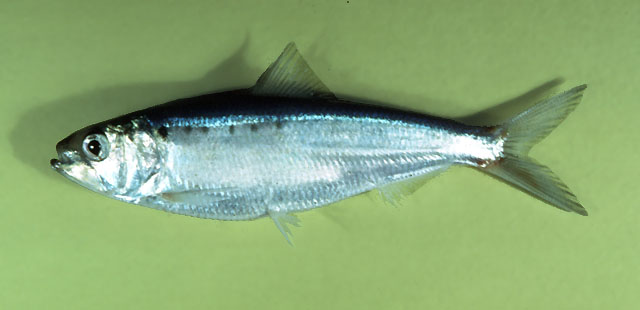| Alosidae (Shads and Sardines) |
| 76 cm TL (male/unsexed); 61.7 cm SL (female); max.weight: 5,500.0 g; max. reported age: 13 years |
|
pelagic-neritic; freshwater; brackish; marine; depth range 0 - 250 m, anadromous |
| North America: Atlantic coast from Labrador, Canada to St. Johns River, Florida, USA; ascends coastal rivers during spring spawning migrations. Introduced into Sacramento River, California in 1870s and has spread along Pacific Coast from Kamchatka, Russia to Todos Santos Bay, Mexico. Landlocked in Millerton Lake, California, USA. |
|
Dorsal spines (total): 0-0; Dorsal soft rays (total): 15-19; Anal spines: 0-0; Anal soft rays: 18-24; Vertebrae: 51-60. Moderately compressed, belly with a distinct keel. Lower jaw not rising steeply within mouth. Gill rakers long and slender (fewer in young). Silvery in color with blue or blue-green metallic luster on back (Ref. 1998). A dark spot on shoulder, sometimes followed by several more, or even a second row. Resembles A. pseudoharengus with lower jaw rising steeply within mouth, eyes larger, and fewer lower gill rakers, as also A. aestivalis and A. mediocris (Ref. 188). Silvery, with a green or bluish back (Ref. 7251). Branchiostegal rays 7 (Ref. 4639). |
| Spends most of its life at sea, returning to freshwater streams to breed (Ref. 27547). Inhabits open water of large rivers (Ref. 86798). Non-spawning adults are found in schools near the surface of continental shelf waters in spring, summer and fall (Ref. 7135); also found in brackish waters (Ref. 4607). Newly hatched larvae are found in rivers during the summer; by autumn they enter the sea and remain there until maturity. Juveniles form schools at 20-30 mm TL and gradually move downstream (Ref. 4639). Feeds on plankton, mainly copepods and mysids, occasionally on small fishes. Feeding ceases during upstream spawning migration and resumes during the downstream post-spawning migration (Ref. 1998). Commercially caught in rivers and estuaries during spawning migration (Ref. 1998). Utilized fresh, salted, or smoked. The roe is esteemed. Eaten pan-fried, broiled, and baked (Ref. 9988). Possibly to 375 m depth (Ref. 6793). Parasites found are nematodes, Acanthocephala, copepods and distomes (Ref. 37032). |
|
Least Concern (LC); Date assessed: 22 August 2018 Ref. (130435)
|
| harmless |
Source and more info: www.fishbase.org. For personal, classroom, and other internal use only. Not for publication.

